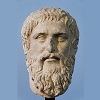4.8: Methodology- Sources and Problem
- Page ID
- 132270
How do we know what we know about the Greek world? Studying Greek history, especially in its earliest periods, is like putting together a puzzle, most of whose pieces are missing, and some pieces from another puzzle have also been added in for good measure. Greek history requires careful consideration of a wide range of sources, which fall into two broad categories: literary sources (including both fiction and non-fiction), and material culture. In a world where social media, television, print newspapers, and radio did not exist, historians need to use other sources, such as epics, lyric poetry, and drama.
The earliest literary sources for Greek history are the Homeric epics, Iliad and Odyssey. Composed orally before the existence of the Greek alphabet, the epics were not written down until sometime in the sixth century BCE. The stories most likely do not reflect the society of any particular Greek city-state in any one period, but rather consist of an amalgam of features from the Bronze Age to the early Archaic Period. More than any other literary source, the Homeric Epics influenced the mentality of the Greeks in thinking about war and what it means to be a hero.
The overwhelming majority of surviving literature is from Athens, which brings it own challenges. The Greeks of the Classical period considered Sparta to be as great a city as Athens. However, Spartans valued military valor over all else, so they did not cultivate arts and letters the way Athenians did. As a result, the only literary sources from Sparta are the works of two poets, Alcman and Tyrtaeus. Tyrtaeus’ military elegies glorify heroic death in battle over life without honor and were likely sung by Spartan warriors as they marched into battle.
Several genres of non-fiction survive too. The works of three major historians survive from Classical Athens. Herodotus, dubbed the Father of History, wrote the Histories about the Persian Wars in mid-fifth century BCE. Thucydides, an Athenian general in the Peloponnesian War, wrote a history of the Peloponnesian War over the course of the war (431 – 404 BCE). Finally, Xenophon wrote a history of the end of the Peloponnesian War, starting with 411 BCE, where Thucydides’ work ended, and into the fourth century.
In addition to the works of the historians, philosophical treatises – most notably, those of Plato and Aristotle – provide crucial insight into the political thought, moral values, and perceptions of the world in the late fifth and fourth centuries BCE. Approximately 100 surviving courtroom speeches provide a window into the Athenian legal system. Finally, the Hippocratic corpus, a series of medical treatises and physicians’ journals from the Classical period, help us to understand the Greeks’ views of the human body and diseases.
In addition to the geographical restrictions of these sources, it is also important to note two other key limitations of the available evidence. First, virtually all of the literary sources were written by men and provide very little evidence of the lives and perspectives of women in the Greek world, except as seen through the eyes of men. Second, most of the authors were wealthy and socially prominent individuals; thus, their perspective does not reflect that of less affluent citizens and slaves.
.png?revision=1)
Archaeological evidence allows historians to fill some of the gaps in the literary evidence, as well as provide key information about different aspects of everyday life in different city-states. For example, the excavations of the sixth-century BCE colony Megara Hyblaea in Sicily show that Greek colonists were interested in city planning and in equality of citizens, as demonstrated by the equal size of the lots.
.png?revision=1&size=bestfit&width=545&height=363)
Material finds, such as pottery remains, in different sites across the Mediterranean allow historians to map trading routes. For instance, Figures \(\PageIndex{1}\) and \(\PageIndex{2}\) show vases that were made in Euboea and Corinth respectively, but were found in Greek colonies in Italy. In addition, images on pottery provide information about stories and myths that have entered popular culture and that sometimes reflect further aspects of everyday life. The prevalence of images of women gathering at public fountains on Athenian hydriae (water pots) from the late sixth century BCE shows the importance of the public fountains for the social life of women in Athens in the period.
Finally, written archaeological sources, such as inscriptions on stone or pottery shards from all over the Greek world, and papyri from Hellenistic Egypt, are the equivalent of documentary archives from the ancient world. The evidence from epigraphy (inscriptions) includes laws that were written on large stones and set up in public, such as the monumental law-code from Gortyn, Crete, and lists of war-dead, as well as private tomb inscriptions.
.png?revision=1&size=bestfit&width=837&height=564)
Papyri include such private documents as prenuptial agreements (among the strangest are prenuptial documents for brother-sister marriages – legal in Egypt but nowhere else in the Greek world), divorce documents, loans, and village police reports (cattle theft appears to have been a serious problem in the Faiyum in the Hellenistic Period!).
Taken together, the literary and archaeological sources allow the historian to complete much more of the puzzle than would have been possible with just one of these types of sources. Still, significant gaps in knowledge remain nevertheless, and are, perhaps, one of the joys of studying ancient history: the historian gets to play the part of a sleuth, attempting to reconstruct the history of events based on just a few available clues.


